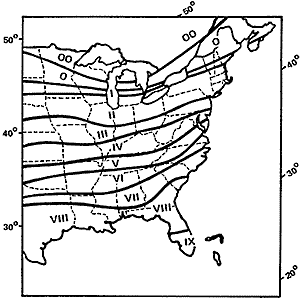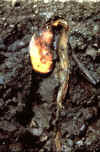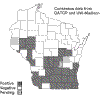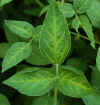Variety Selection
Last updated on
February 23, 2014
Criteria for selecting soybean varieties
- Yield potential
- Maturity
- Standability
- Pest resistance
- Special considerations
Yield potential
- Yields are increasing about one-third of a bushel per acre per year due to genetic
improvement.
- Example of Wisconsin Soybean Variety Trial Results
- Most soybean varieties have genetic yield potentials well over 100 bu/A.
- The best measure of variety performance is a multi-location average and consistently
high performance.
- GxE interactions
- When a set of varieties is tested for yield over a range of environments, their
rank order commonly changes, which indicates that some varieties are better adapted
to a specific environment than others.
- Sometimes it is best to select varieties with characteristics that will help them
perform well in the cultural system and environment to be used rather than on yield
alone.
- For example, if excessive growth and lodging are problems, then select varieties
that are medium to short in height with good standability. If the field has a history
of Phytophthora, then select resistant or highly tolerant varieties to address
that problem.
Maturity
- Maturity groups (000-X)
- Photoperiod
- Types
- Determinant: at flowering, plant height growth stops.
- Indeterminant: at flowering, plant height growth continues (typically found
in WI)
- Determinant semi-dwarfs: plants shorter in stature than determinant varieties
- Semi-determinant: plants that continue to grow slightly after flowering begins

|
With the exception of yield, which reflects the total response of a variety to a
set of growing conditions, maturity is the most important criterion in selecting
a variety. If a variety is too early or too late at a location, it will be limited
in potential performance.
Soybean varieties are classified into 13 maturity groups, from Group 000 grown in
Canada to Group X grown in the tropics.
Generally, each 10-day delay of planting in May delays maturity 3 to 5 days in the
fall.
The earliest and latest varieties within a group may differ by as much as two weeks
in maturity.
Maturity information should be used to select varieties that mature at different
times to allow for timely harvest in the fall. Group II through 00
varieties are best adapted to Wisconsin conditions. The lines across the map are
approximate limits of adaptation and are not meant to represent rigidly defined
areas where a variety is or is not adapted. Cultivars from Group II to 00
when planted in mid-May in Wisconsin, will reach maturity by early September to
early October, depending on the weather, location, and planting date.
The average date of maturity of most currently available soybean varieties is evaluated
in the variety tests in Wisconsin.
Maturity is noted as when 95% of the pods have turned brown. This is not harvest
maturity, but is the time when seeds are physiologically mature and additional dry
matter will not be accumulated. Harvest maturity will be reached 10 to 20 days later,
depending upon the weather.
Photoperiod
Soybeans are photoperiod (number of hours of light) sensitive.
When varieties are moved south of the area where they are typically grown:
- they mature faster than normal,
- resulting in seed fill occurring during the hot, dry period of July and August.
When varieties are grown north of where they are adapted:
- maturity is delayed,
- resulting in seed fill during the cool, short days of fall.
- Frost before the crop reaches maturity is a possibility.
The latest variety used should be one that reaches physiological maturity just prior
to the date when there is a 20 percent chance of a killing frost in the fall.
Yield performance will often tell us when a variety is too late or too early, since
yields of these varieties-will be lower than those of adapted varieties.
The onset of flowering in soybeans is photoperiod controlled. Soybeans are classified
as "short-day plants," which means the plants will develop vegetatively
until a critical daylength is reached that "triggers" the flowering response.
In Wisconsin, flowering usually begins in early July as the daylength decreases
after the maximum daylength on June 21. This period is the time of the most flowering
activity for adapted soybean varieties in Wisconsin.
Flowering
Indeterminant Types
- Nearly all of the soybean varieties in maturity groups II and 00
are indeterminant types, with flowering activity
- Flowering is spread over a 3 to 5 week period once the critical daylength
has occurred.
- In indeterminant types, flowering begins at the lower nodes and progresses
upward on the plant.
- The long flowering period allows these types to adjust to the effects of short-term
stress or unfavorable environmental conditions.
Determinant Types
- Determinant types of soybeans have a much shorter flowering period (2 to 4 weeks)
- They cease main-stem growth once flowering has been "triggered,"
although vegetative branching may continue.
- Flowering in determinant soybeans is generally simultaneous at all nodes.
- Determinant varieties have about half the plant height and number of nodes
compared to indeterminant types.
- Determinant varieties may require higher seeding rates or narrow-row planting
to provide more plant-to-plant competition and to produce greater height from the
ground to the lowest pod.
Two modifications are the determinate semi-dwarf and semi-determinate varieties.
- Determinate semi-dwarfs
- true determinate varieties
- half the height of normal varieties.
- Semi-determinate varieties
- 6 to 10 inches shorter than indeterminant varieties
- add only a small amount of vegetative growth after flowering and podding begin.
Flowering periods of both types are slightly shorter than in commonly grown varieties.
Determinate semi-dwarfs and semi-determinates are more lodging-resistant than taller
types and may yield more in high productivity environments (50 + bu/A).
Management and Flowering
Because soybean flowering is controlled by photoperiod, planting date affects
the size of the plant attained before flowering begins. Soybeans planted later have
less time to develop vegetatively and thus will be shorter in size. Planting dates
of May 10 to 20 provide long enough times of development for adequate vegetative
growth with the indeterminant soybeans and provide good yield potential. Planting
after June 1 generally results in lower yields due to reduction in the vegetative
size of the plants. Pod formation and seed-filling periods are critical for the highest
yield of soybeans. The photosynthetic rates of soybeans are highest at flowering
and pod filling. Stress at these critical times, caused by drought, excess
heat, mineral deficiency, etc., can cause the greatest yield reduction.
Several high yield potential varieties in maturity groups II and 00
are available for Wisconsin producers. Irrigation tends to delay maturity,
and the early varieties have responded better to irrigation. In dryland production,
the yield differences between early and late soybeans may not be as much, although
full-season varieties will generally outperform early varieties in the long run.
Because of the potential for frost and late harvest, circumstances will seldom dictate
choosing a variety that will mature too late. However, the following situations
may suggest the selection of shorter-season varieties:
- If planting winter wheat is frequently delayed by harvest of full-season soybeans,
you may wish to use early maturing varieties for greater timeliness;
- If planting is delayed until mid to late July, shorter-season varieties may be required;
- If excessive lodging is a problem with full-season varieties, short-season varieties,
which normally lodge less, may be used as a second choice to combat standability
problems on highly fertile and moist soils.
Standability
Lodging scores are reported in performance test results. These ratings give an indication
of standability in various environments and locations. Lodging reduces yield and
makes harvest more difficult, so good lodging resistance is important. Lodging of
soybeans at the beginning of seed fill, when beans start to increase in size, is
most detrimental to yield. Taller varieties are generally more susceptible
to lodging. Determinant varieties are virtually resistant to lodging.
Variety dependent
- Both the genetic makeup of a variety and the environment in which it is grown can
be responsible for standability problems.
- Moist, fertile soils normally stimulate vegetative growth in soybeans and lead to
tall lodging-prone plants.
- Certain varieties are inherently more susceptible to lodging than others.
- Use yield trials in which some lodging is present among most varieties, as opposed
to trials in which there is no lodging.
Seeding rate
- You can also use several management practices to reduce lodging.
- Reducing the seeding rate is a first step.
- Choosing slightly shorter-season varieties is sometimes helpful. Planting
earlier or later than normal is often beneficial. In high-yielding environments
(good moisture and fertility) where lodging is a problem even after all of these
management practices have been initiated, using determinate semi-dwarf varieties
may be indicated. These varieties lodge very little in most situations. However,
they require intensive management.
Branching versus thin-line types
- Soybean varieties have different growth habits which can be exploited.
- The range is from highly branching types to thin-line types which produce a single,
main stem.
- The type of production system to be used (narrow-row vs. wide-row, irrigation vs.
dryland) may make selection of a variety with a specific plant type beneficial.
Row width and plant population may alter the growth habit of soybeans enough to
somewhat change the degree of branching. For best yields in wide rows, select full-season
varieties with a bushy growth habit.
- Branching may be beneficial if lodging is a problem or if hail is a risk.
Plant height
- Height frequently doubles after the first flowers appear.
- Taller varieties are generally more susceptible to lodging.
- Shorter varieties tend to out yield taller varieties when irrigation is used.
Pest resistance
|
Phytophthora root rot
|


|
|
Brown stem rot
|
|
|
White mold
|
|
|
Soybean cyst nematode
|

|
|
Soybean aphid
|
|
|
Bean Pod Mottle virus
|






|
Losses due to disease in soybeans can be a serious problem in Wisconsin. Researchers
are developing varieties resistant to diseases, nematodes and nutrient problems,
but few insect-resistant varieties have been developed. Resistance or tolerance
has been bred into soybeans for phytophthora root rot, soybean cyst nematode, root
knot nematode and some leaf diseases. Use of resistant or tolerant varieties is
the best method of disease control. Changes in production practices, such as crop
rotation, may also aid in disease control.
Some diseases are seed-borne. Selection of seed for planting that is free
of these diseases is important in reducing loss of production due to these diseases.
Phytophthora root rot, a soilborne disease that affects soybean growth
in poorly drained, heavy soils, is another fungus disease. Several different races
of the fungus Phytophthora megasperma var. sojae cause this disease.
Seedlings "damp off" when this fungus infects the plant, while older plants
turn yellow, their leaves wilt, and their roots rot until the plant dies. Use of
resistant or tolerant soybean varieties is the best prevention of this disease.
Many high-yielding varieties with resistance or good field tolerance to the races
of phytophthora found in Wisconsin are available from public and private sources.
Economic insect damage of soybeans in Wisconsin is not extensive. Foliage feeding
insects can be present and may cause no yield reduction, depending on time
and extent of feeding. Soybeans can tolerate fairly high levels of defoliation (10-35%)
during the vegetative development stages without reduction in yield. After blooming,
loss of up to 20% foliage will not be detrimental.
Nematodes, particularly soybean cyst nematodes, are an increasing problem
in much of Wisconsin. This problem is often first noticed when patches of short,
yellow plants appear in the field. However, the pest can be present at levels that
reduce yields without causing easily visible symptoms. Roots can be examined for
the presence of the cyst nematode. It is preferable to collect soil samples and
send them to a diagnostic clinic for analysis. Both number and race of cyst nematodes
present can be determined. If conditions are such that a resistant variety is needed,
many are available from public and private sources.
County extension centers and reputable seed dealers generally have listings of disease-resistant
varieties. First, determine, with their help, what the disease problem is. Then
find varieties adaptable to your situation with resistance or tolerance to this
disease. It is generally a good practice not to use disease-resistant varieties
unless a disease problem is actually present.
Special considerations
- crop use
- seed cost
- seed size
- vigor and emergence
- shattering resistance
Food uses
For some uses, yellow hila large-seeded varieties are appropriate; for others,
small-seeded varieties are preferred. Production for these markets requires
that only certain varieties be grown.
Seed cost
Seed cost may influence choice of variety. If costs of two varieties differ, make
sure there is enough potential yield difference to justify the extra expense. In
most cases, a bushel or two of increased yield will cover any increase in seed cost.
It is important, however, for you to shop around to find the best price on the highest
quality seed of a given variety.
Seed size
Seed size also merits consideration. Small-seeded varieties do not require as many
pounds of seed per acre, so they are worth more per bushel. Because of variance
in seed size among varieties, seeding rates should be calculated on viable seed
planted per ground area rather than on weight of seed.
The selection of medium or small seed when using a grain drill will improve metering
and stand uniformity.
Seed size is not directly correlated with yield potential as several smaller-seeded
varieties have high yield records and vice versa.
Seed size is markedly influenced by the environment during the seed enlargement
period of growth. Seed size reduction caused by moisture or other stress at the
seed-enlargement period can reduce yield substantially.
Larger-seeded varieties could encounter more difficulty in emergence than
smaller seeded varieties, particularly in cool soil conditions. However, over the
range in seed sizes among varieties grown in Wisconsin (from 12 to 20 g/100 seeds),
this effect is not marked. Environment plays a large role in affecting seedling
emergence. Heavy rainfall immediately after planting can cause compaction and crusting
on some soil types, making emergence difficult. The use of a rotary hoe will help
break the crust and enable even the largest-seeded varieties to emerge.
The emergence score of soybeans represents the ability of the seed to emerge under
unfavorable conditions in a laboratory test. This test indicates that more than
seed size is involved in emergence ability of soybeans. If soybeans are to be grown
on soil with a crusting problem, or if planting depth must be deep (sandy soils),
the emergence score may be a necessary criteria for variety selection.
Shattering
The development of varieties that do not shatter has improved harvest characteristics
of soybeans. Environmental conditions at time of maturity influence shattering.
Early maturing varieties tend to be more prone to shattering than later-maturing
varieties. Shattering is markedly different from year to year.